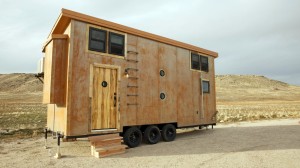
While some people collect so much stuff that they can’t park cars in box-filled garages, others are moving in another direction: minimalism.
Minimalism is the lifestyle that focuses on owning less and experiencing more. But it’s not restricted to owning fewer possessions. It focuses on having fewer ties to the things that society says people should have.
Matt and Sarah Park purchased a 1978 green Volkswagen bus named Magnolia in 2010. After Sarah graduated from BYU in 2012, the couple worked late shifts and felt like they were not able to spend time together.
On Nov. 9, 2014, they officially moved into their Volkswagen and have since completed a full year of what many consider “dirt-bagging” but what the Parks call “The Bus Life.”
After a trip to Red Rocks, which included rock climbing and camping, they lived for 10 days in their van.
The couple said they avoided common messes that pile up during typical camping trips. “It felt like home,” Sarah said. “It never felt like we were on vacation. We had everything organized because we had our systems.”

Matt and Sarah’s lifestyle is just one example of the minimalistic lifestyle. Matt said none of his friends followed the traditional life path of going to school, getting a job and working their way up. He feels that more people are moving toward this lifestyle.
“The shift is coming from people seeing others following their passion and finding their freedom in sizing down, since we don’t need that much to survive,” Matt said. “That stuff just adds stuff and not happiness.”
After their first van, Matt and Sarah moved into a more accommodating vehicle: a space with a heater, air conditioning and room for 6-foot-7-inch Matt to sleep without his feet hanging off the end.
Beckett, their 2007 Chevy Express, is a van with a custom extended roof and a custom interior that has a stove, sink, refrigerator and other amenities necessary to exploring Utah, even in the winter.
But living in a van is not the only type of minimalistic lifestyle that people are moving toward. Angus MacInnes owns Maximus Extreme Living Solutions, a Utah-based company specializing in constructing tiny homes all over the nation. These homes are typically around 400-square-feet and come in all shapes and styles, and even come on wheels. MacInnes says that the biggest appeal or draw to homes like this and minimalistic living is “freedom.”
“Tiny homes can offer a sense of freedom for people on multiple fronts, thus giving people a sense of control in their living arrangement,” MacInnes said. “Freedom from a large mortgage, freedom to travel, architectural and creative freedom in their design, really the list can be as large or small as the individual wants, which once again denotes freedom, specifically the freedom to choose.”
Minimalist living not only offers the physical freedom that many people search for as they join this movement but also the economic freedom. The concept of “less is more” is a common theme with a minimalist lifestyle.

The Sarah House Project in Salt Lake City is a non-profit organization that provides homes built out of shipping containers for those that are under-served.
The average shipping container costs $3,000, and anyone can buy them. Three or four of these 40-foot containers, with a little bit of modification, can provide a large living space that is considerably cheaper than the average home.
Head of the Sarah House project Jeff White started almost 10 years ago in search of helping those that don’t have a home.
“People want a porch and to interact with their neighbors,” White said. “This new generation isn’t looking for gated communities or a giant house. There may be some people that want that lifestyle, but most are coming out of college and are just entering the market.”
White said many people don’t have the kind of money for a brand new home and are looking to take weekends off to go skiing or do what they love.

“Why would you want to have a home that will take a lifetime to pay off when you could have a home that costs as much as a brand new car?” White said.
A completed home costs just over $10,000. White has been contacted by people all over the world concerning the costs of building, financing and owning shipping container homes as other countries look into them for affordable housing for the homeless.
But what is the appeal to students and people in their twenties? Michele McIntosh lived in many different low-cost living situations during her twenties. From RVs to her Subaru, she spent her time adventuring and living the way she wanted to.
“The benefits of being a minimalist appeal greatly to young adults due to the emphasis on owning less equals working less,” McIntosh said. “The understanding that consumerism rarely contributes any meaning or value to life and the fact that living simply creates freedom on so many levels.” She believes that finding a passion and creating a lifestyle around those views is extremely fulfilling.
With many students leaving college with student loans and other costs like families and housing, minimalism may be a way to do what they love while owning and working less.




